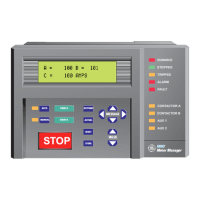GE Power Management
MM2 Motor Manager 2 9-7
9 STARTER TYPES 9.3 TWO SPEED STARTER
9
9.3.2 MM2 SEQUENCES
START LOW SPEED sequence:
1. Start A command received by the MM2 (serial, switch input or faceplate).
2. Close and maintain Contactor A relay – the motor is now in low speed.
START DIRECTLY TO HIGH SPEED (motor stopped, HIGH SPEED START BLOCK not enabled)
sequence:
1. Start B command received by the MM2 (serial, switch input or faceplate).
2. Close and maintain Contactor B relay – the motor is now in high speed.
START DIRECTLY TO HIGH SPEED (motor stopped, HIGH SPEED START BLOCK enabled) sequence:
1. Start B command received by the MM2 (serial, switch input or faceplate).
2. No response to start B commands.
LOW TO HIGH SPEED TRANSITION sequence:
1. Start B command is received (serial, switch input or faceplate).
2. Open contactor A output relay.
3. Close and maintain Contactor B relay – the motor is now in high speed.
HIGH TO LOW SPEED TRANSITION sequence:
1. Start A command is received (serial, switch input or faceplate).
2. Open contactor B output relay.
3. Wait for the programmed transfer time.
4. Close and maintain contactor A.
STOP/TRIP sequence:
1. Stop command received by the MM2 or a trip occurs.
2. Open the currently closed contactor output relay.
There are many different configurations for the TWO SPEED starter type. Three of the more popular
ones are illustrated here: two-speed one winding constant or variable torque, two-speed one winding
constant horsepower, and two-speed two winding. See the two speed starter diagrams on the follow-
ing pages.
When the power to the MM2 is interrupted, all MM2 output relays de-energize, causing them to open
and stop the motor. The MM2 can only be wired for fail-safe operation.
If feedback is not received from the L or H contacts to the Contactor A or B Status N.O. input within
one second of closing Contactor A relay, an OPEN CONTROL CIRCUIT alarm will occur. This will
cause Contactor A and B output relays to open.
If feedback remains at the Contactor A or B Status N.O. input more than one second after opening
the Contactor A or B output relays, a WELDED CONTACTOR alarm will occur.

